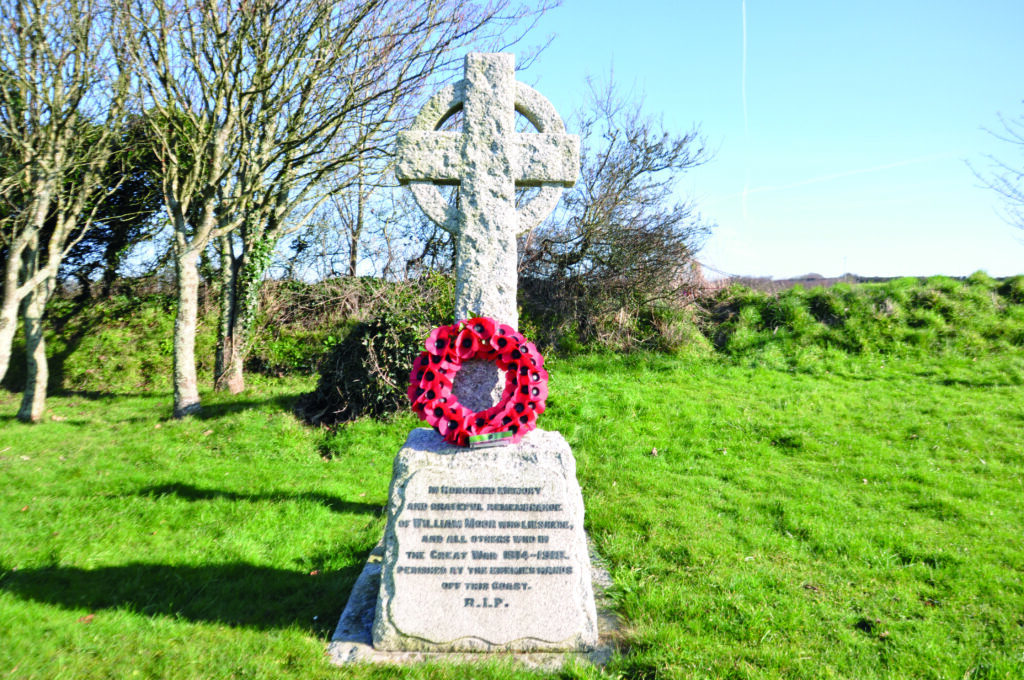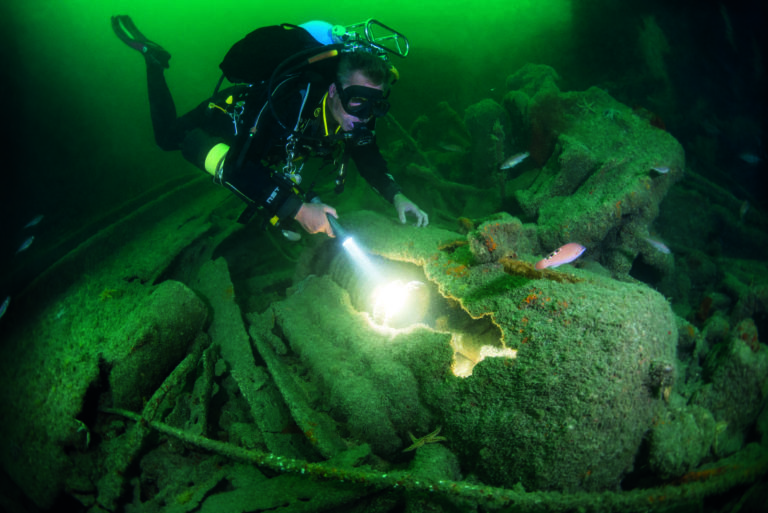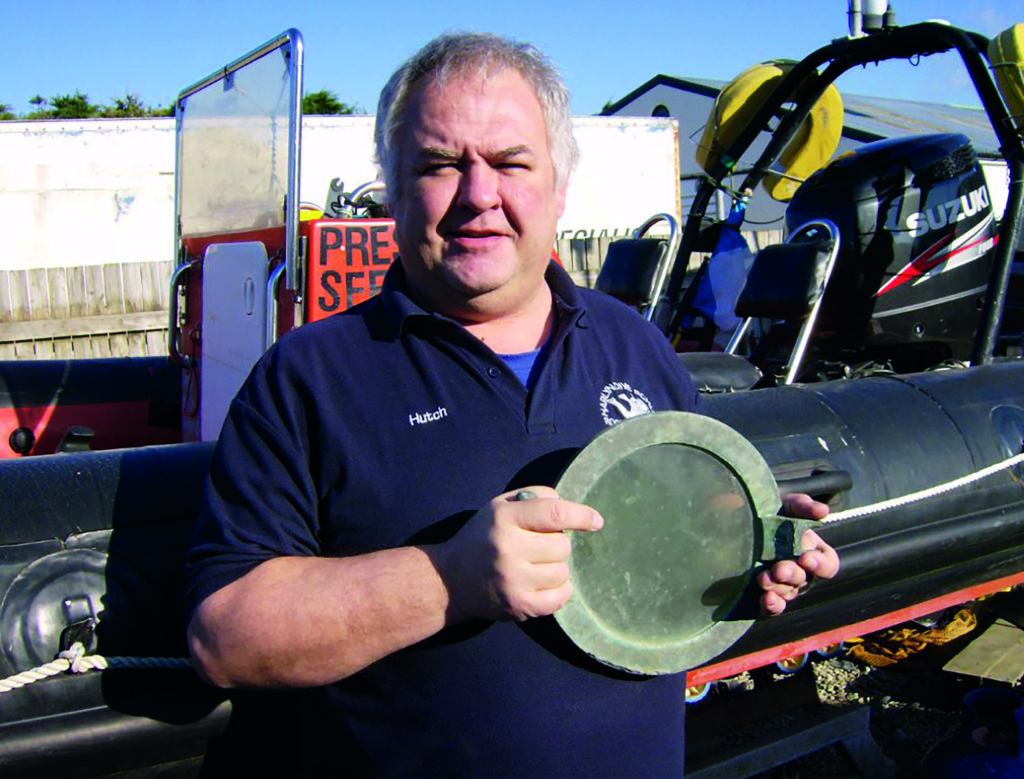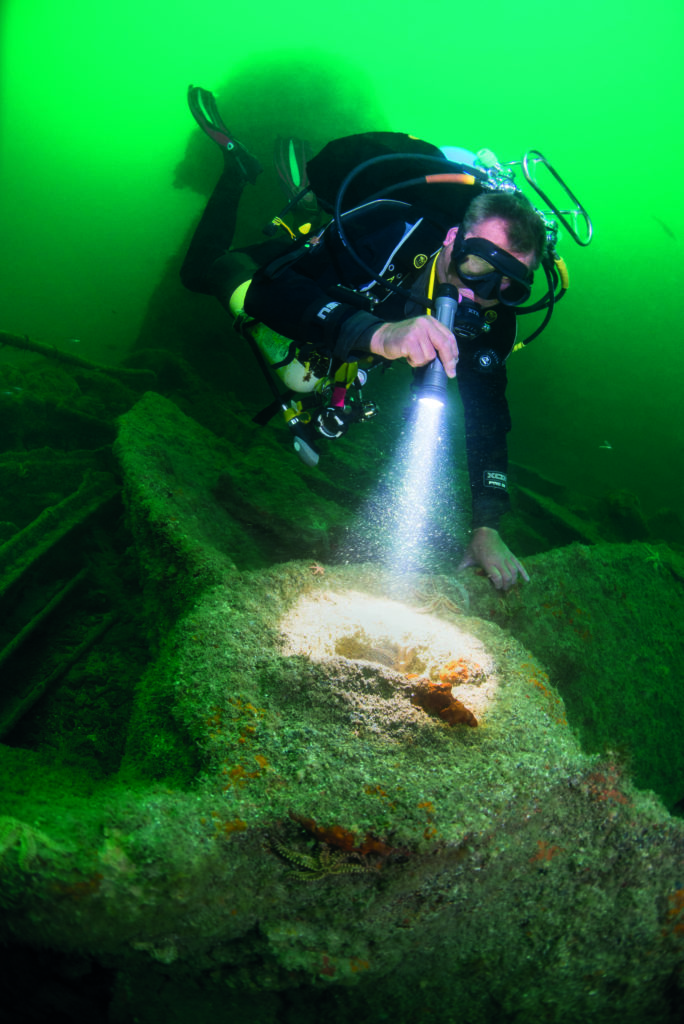STUART PHILPOTT is on the look-out for a gun linked to a 100-year mystery when he dives a shipwreck out of Padstow in Cornwall
The lure of a 100-year-old mystery was just too much to ignore. Steve ‘Hutch’ Hutchinson, the owner of Harlyn Dive School, had invited me along for a day’s diving on the Anna Sofie, lying off Padstow in Cornwall. The World War One wreck had recently made local news headlines because of an unmarked gravestone at the local cemetery, so this is where my story begins…

Mystery stone
Obscured by the more ornate headstone of Private William Moor’s grave was another smaller, insignificant grave, that of an “unknown” soldier. For nearly a century, the stone inscribed with “a Royal Marine of the Great War” had remained a mystery. But after some nifty detective work, Padstow Museum chairman John Buckingham and Sussex-based historian Peter Smith had unravelled the true identity of the dead man.
The 97m, 2,577-ton armed merchantman Anna Sofie was returning to Wales in ballast on 23 July, 1918 when, without warning, she was torpedoed by the U-boat U-55, commanded by the infamous Kapitanleutnant Wilhelm Werner.
The crew of around 70, including critically wounded marine gunner Pte William Moor, had managed to escape in the lifeboats and were picked up at sea. Some 19 days later, the unknown soldier had washed up on the beach at Padstow, but the badly decomposed body could not be formally identified, so was buried next to Pte Moor without a name on the headstone.
John and Peter had waded through historical archives, military records and local reports, compiling enough evidence to prove that the unidentified soldier was in fact 42-year-old Lance-Corporal William Whitmore, who had also been on board the Anna Sofie when she sank.
After 100 years of speculation, the descendants of L/Cpl Whitmore’s family had the full story at last. Since this discovery, a new gravestone has been placed in the cemetery, engraved with his name.
From July 1916 to November 1918, U-55 completed 14 successful patrols, sinking a total of 64 mostly unarmed vessels, including hospital ships (133,742 tons).
During the Leipzig war-crimes trials at the end of WW1, Kapitanleutnant Werner was accused of many atrocities, including murdering the entire crew of ss Torrington bar the captain, who was taken hostage. It was alleged that the captured crew of 32 had been lined up on the U-boat’s foredeck before Werner gave the order to submerge, undoubtedly drowning them all.
But before the trial concluded the unscrupulous submarine captain had fled to a coffee plantation in Brazil. Years later he returned to Germany, where he died in May 1945 at the age of 57.
The ‘unknown’ wreck
It seems that the wreck itself had also previously caused a stir. Hutch said there had been conflicting reports regarding its true identity, with many divers thinking the Anna Sofie was the cargo steamer Poldown.
Hutch had carried on searching for evidence, and in April 2011 had found the serial number 1275MC stamped on a steam valve, confirming that the wreck was indeed the Anna Sofie. He had reported his findings to the hydrographic office (UKHO) and the records had been updated.
Even though the Anna Sofie is steeped in history, it was not a popular choice with local divers. “It’s seen as an ‘in-between’ wreck – it’s a bit deep for most divers,” said Hutch. “Scooby Doo’ers prefer 30m or less, and it’s too shallow for most techies.”
Hutch has clocked up more than 100 dives on the wreck since the early 1990s. Finds have included a substantial number of brass shell-cases, port-holes and engine components. But the prized 4in deck-gun manned by marine gunner L/Cpl William Whitmore has yet to be found.

The wreck is located in the middle of Padstow Marine Conservation Zone. “It sits right next to a reef wall, so it’s difficult for boats to find and then, if they do find it, a lot of divers don’t go to the end of the shotline and drop down onto the reef, missing the wreck,” Hutch told me.
We made plans to do two dives at the site on the same day, which meant catching both slack tides. This would give me a good six hours to off-gas between dives.
Harlyn Dive School’s 8m RIB fitted with a single 250hp outboard covered the 8.5-mile journey from Rock Beach to the wreck in 20 minutes flat. I was kitted up and back-rolling into the sea by 10.45am.
My first dive, with Andrew St John Ricks, was at high water, to a maximum depth of 43m. We had agreed to start amidships and then move forward towards the bow.
I was disappointed with the visibility, which topped out at 4-5m. High tide is usually better than low water, so this didn’t bode well for my second dive in the late afternoon (the last time I had visited Rock to dive on ss Sphene, we had enjoyed 10m-plus).
Hutch had dropped the shotline roughly amidships on the port side. I followed Andrew down to the reef-wall and caught sight of an elongated, bomb-shaped object that turned out to be a heating element of some kind. The outer casing had rotted away, and I could clearly see a helical shape inside.
We passed two large boilers, paused at a four-bladed propeller (presumably a spare prop stored in the cargo hold) for a picture or two, and then headed for the bow.
My camera lights illuminated a huge rusty-red metal plate loaded with colourful starfish. Lobster and conger eels were peering from the darker recesses – there was no shortage of marine life.
We investigated some winches, a bollard with a spider crab lurking on top and a length of anchor-chain. The pointy bow shape had collapsed, as had much of the surrounding superstructure.
We ended up back at the boilers, which was the highest point of the wreck, standing 5m proud of the seabed. The dive had lasted 38 minutes and there had been plenty of interesting bits and pieces to keep my camera occupied. The only downsides were the time restraints and the low-ish visibility.
Dive two
The pace ramped up considerably on my second dive at low water to a maximum depth of 38m, this time with Hutch as guide. On the plus side, underwater visibility was much better than expected, but at 5pm there was less ambient light to play with.
I wanted to re-trace the areas already visited with Andrew before heading off to the stern, rudder and propeller, but trying to do the whole length of the wreck and compose pictures in 20 minutes was being slightly over-optimistic.
The massive triple-expansion engine manufactured by Blair & Co, which Hutch finds so impressive, towered above us. I managed to compose an atmospheric silhouette of the block and pistons with Hutch in the foreground.
After making a quick detour to the donkey boiler, we crossed over the propshaft and headed for the stern. I was hoping that the giant prop would make a nice wide-angle shot, but as prop-shots go this wasn’t going to be easy.
There was no room for me to wedge behind the prop and shoot out towards the light, so I had to make do with a dark background shot, which just lit up all the silt particles like a snowstorm. Hutch had been shifting along at a lightning pace, and I was starting to feel slightly nauseous with over-exertion.
We passed close to the reef wall on our journey back to the shotline. Hutch pointed to a row of protruding antennae, which turned out to belong to crawfish, all looking to be a good “edible” size. This was the first time I had seen this species in UK waters.
Unfortunately, there was no spare time for pictures, because my deco was already starting to mount up. Some 44 minutes later, we broke the surface.
In hindsight
On both Anna Sofie dives, I used a nitrox 28 mix. In hindsight, a weak trimix fill would probably have been a better option for a clearer head.
I really enjoyed spending the day with Harlyn Dive School, which is based at Rock, and Hutch and Andrew had proved to be the perfect guiding and modelling combination. So no complaints from me, although I think my pictures could have been better, but what’s new?
From a historical background perspective, the unknown-soldier angle had made the dives far more interesting, although I was slightly disappointed that we didn’t find the deck-gun.
At least the 100-year-old mystery had been solved and L/Cpl Whitmore’s family had got some closure. In passing, Hutch mentioned that a number of German U-boat wrecks lay off Padstow, one with a very photogenic deck-gun still intact. Temptation can be a terrible thing!
Photographs by Stuart Philpott
Also on Divernet: Diving The Royal Adelaide, Why Dorset Dive Kyarra Is A National Treasure, Diving Chesil Bank, The Countess Of Erne, Exploring HMT James Fennel




